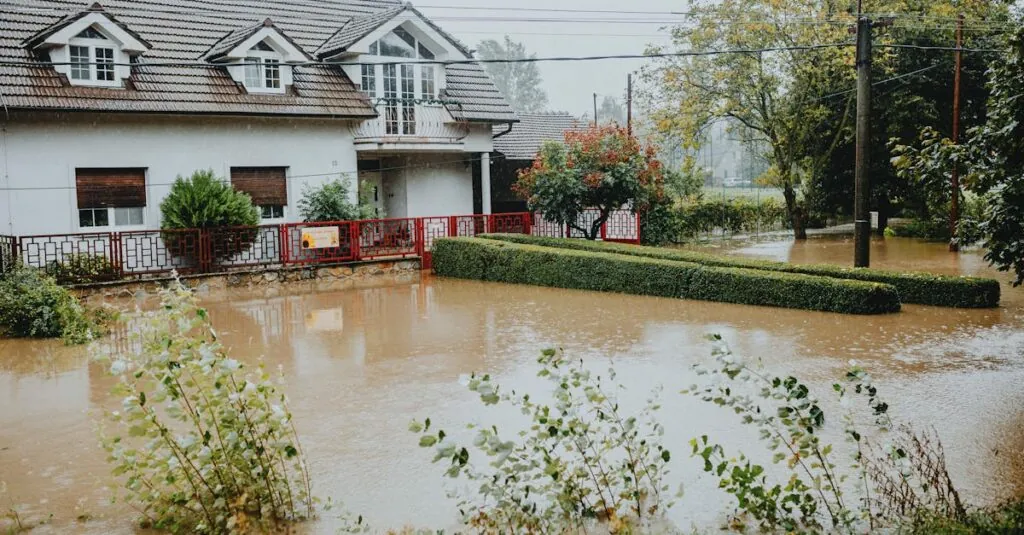Table of Contents
ToggleImagine this: you’re hosting a dinner party, and just as you’re about to impress your guests with your culinary skills, the dog decides that the tablecloth is its new chew toy. Suddenly, your beautiful dining room turns into a scene straight out of a comedy show. Accidental damage happens when you least expect it, and that’s where home insurance swoops in like a superhero with a cape—well, sort of.
Home insurance often covers accidental damage, but not all policies are created equal. Understanding what’s included can save you from financial headaches later on. So, before you let your furry friend roam free or attempt that DIY project you saw online, it’s worth knowing how to protect your home from those unexpected mishaps. After all, a little knowledge can keep your home—and your sanity—intact.
Understanding Home Insurance Accidental Damage
Accidental damage in home insurance represents an essential coverage component. This coverage protects homeowners from unexpected incidents that result in property damage.
Definition of Accidental Damage
Accidental damage refers to unintentional harm caused to property. Homeowners might experience sudden events like spills, falls, or breakages affecting the home’s structure or belongings. Examples include a child breaking a window while playing or a visitor accidentally knocking over a vase. Coverage often extends to repairs and replacements, depending on the insurance policy terms. It’s vital to understand that some policies classify certain types of damage differently. Knowing the specifics helps ensure adequate protection against unforeseen mishaps.
Importance in Home Insurance Policies
Inclusion of accidental damage coverage greatly enhances home insurance policies. This feature mitigates financial ramifications of unexpected events, preventing costly out-of-pocket expenses for homeowners. Additionally, it promotes peace of mind, knowing that everyday accidents won’t endanger financial stability. Understanding policy details is essential, as coverage varies among providers. Some homeowners opt for add-ons for more comprehensive protection, which further safeguards against accidents. Accurate protection allows for more confidence in managing home-related risks effectively.
Coverage Offered by Home Insurance
Home insurance provides essential coverage for accidental damage, safeguarding properties from unexpected mishaps. Understanding the specifics of this coverage proves crucial for effective risk management.
Types of Accidental Damage Covered
Accidental damage coverage typically includes a range of incidents. It often covers spills caused by food or drink; these accidents can lead to costly repairs or cleaning services. Breakages of items such as windows, doors, and appliances may also fall under this protection. Damage to the home caused by children’s activities or pets usually qualifies for coverage. Comprehensive policies often encompass structural harm due to unforeseen accidents, ensuring that homeowners are not left with unexpected bills.
Exclusions to Be Aware Of
Certain exclusions exist within most home insurance policies concerning accidental damage. Intentional damage or negligence usually doesn’t receive coverage, placing responsibility on the homeowner. Wear and tear from normal use, such as fading paint and aged carpets, often remains outside the policy’s scope. Additionally, damage from natural disasters may not fall within accidental damage coverage, requiring separate policies. Understanding these exclusions ensures that homeowners maintain realistic expectations concerning policy limits.
Assessing Your Home’s Risks
Assessing risks helps homeowners understand their vulnerability to accidental damage. Various factors influence these risks, including lifestyle, property type, and unique household conditions.
Common Risks of Accidental Damage
Accidental damage often stems from everyday activities. Spills from food or drinks frequently lead to costly repairs. Pets might cause unexpected damage, especially if they knock over items or chew on furniture. Children also contribute through their playful nature, often breaking toys or creating messes. Appliances can malfunction, resulting in water damage or electrical issues. All these scenarios highlight the diverse range of risks homeowners face daily.
How to Evaluate Your Coverage Needs
Evaluating coverage requirements involves examining individual circumstances. Homeowners should consider factors like property value and contents when assessing necessary coverage levels. Reviewing previous incidents offers insight into potential future claims. Connecting with insurance agents helps clarify coverage options and limitations. Assessing personal habits, such as entertaining guests or pet ownership, identifies specific areas for additional protection. Adapting coverage according to these findings ensures proper safeguarding against accidental damage.
Finding the Right Home Insurance
Securing the right home insurance involves careful evaluation of various providers and their offerings. Homeowners must recognize that not all insurance policies are created equal.
Comparing Different Insurance Providers
Start by researching multiple insurance providers to assess coverage options and pricing. Each provider presents distinct features, premiums, and customer service levels. Checking online reviews can shed light on policyholder experiences, helping homeowners make informed choices. Additionally, comparing quotes helps identify competitive pricing while ensuring necessary coverage is included. Tools like online comparison websites can streamline this process, allowing side-by-side evaluations. Attention to each policy’s details highlights critical nuances, such as exclusions and limits on accidental damage.
Factors to Consider When Choosing a Policy
Consider several factors when selecting a home insurance policy. Coverage limits should align with property value and potential repair costs. Assessing deductibles plays a crucial role; lower deductibles result in higher premiums, while higher deductibles may save money upfront but increase out-of-pocket expenses. Understanding specific accidental damage coverage is vital, as some policies offer more robust protection than others. Evaluate additional features, such as personal property protection and liability coverage, which further enhance security. Finally, engaging with insurance agents can provide tailored advice and clarity on specific needs.
Filing a Claim for Accidental Damage
Filing a claim for accidental damage involves specific steps that ensure efficient processing. Documenting the incident immediately helps establish a clear record. Taking photos of the damage provides visual evidence for the claim. Reporting the incident to the insurance company promptly facilitates quicker processing. Gathering receipts or proof of ownership for damaged items supports claims of lost or broken property. Understanding policy details proves essential; knowing what is covered helps in effectively navigating the claim process.
Steps to Take After an Incident
After an incident occurs, taking immediate action can significantly improve the claims experience. First, assess the extent of the damage carefully and prioritize safety. Next, notify your insurance provider as soon as possible to kickstart the claims process. Collect necessary documentation, including photographs and receipts, to substantiate your claim. It’s helpful to compile a list of affected items, noting their value and condition before the incident. Acting quickly keeps information organized and ensures timely support from the insurance company.
Common Mistakes to Avoid
Avoiding common pitfalls can streamline the claims process. Not documenting the damage is a frequent mistake that can hinder claims approval. Neglecting to notify the insurance provider promptly may result in delays or denial of the claim. Failing to read and understand the policy details often leads to unexpected surprises during the process. Additionally, overlooking required documentation like receipts can weaken a claim’s validity. Staying informed about the claims process and maintaining organized records enhances the likelihood of a smooth resolution.
Home insurance with accidental damage coverage offers essential protection against unexpected mishaps that can disrupt daily life. By understanding the specifics of their policy and evaluating their unique risks, homeowners can make informed decisions that safeguard their property and finances.
Taking the time to compare insurance providers and their offerings ensures that individuals find the best coverage for their needs. Documenting incidents and following the proper claims process can significantly enhance the chances of a successful resolution.
Ultimately, being proactive and knowledgeable about home insurance can lead to peace of mind, allowing homeowners to enjoy their space without the constant worry of unforeseen accidents.







